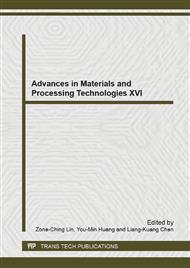p.349
p.355
p.361
p.367
p.373
p.381
p.391
p.400
p.409
Verification of Numerical Roll Forming Loads with the Aid of Measurement Equipment
Abstract:
Roll forming is an important forming process for profile manufacturing in mass production. The design of the process has an important influence on the quality of the products. Therefore, the knowledge of the occurring loads during the roll forming process, e.g. forces and pressures, is essential for the process design. However, the experimental determination of the occurring contact normal pressures in roll forming processes poses a challenge. Finite element simulations offer the potential to approximate contact normal loads and thus, enable a better process design. Nevertheless, due to simplifications of the numerical model, a realistic and reliable output of loads in roll forming is not possible. An enhanced numerical model could provide more valuable information. This paper will demonstrate the reproduction of realistic contact normal pressures and load forces in a roll forming simulation. To verify the numerical values, they will be compared to data gained by experiments.
Info:
Periodical:
Pages:
373-380
Citation:
Online since:
May 2014
Authors:
Keywords:
Price:
Сopyright:
© 2014 Trans Tech Publications Ltd. All Rights Reserved
Share:
Citation:


